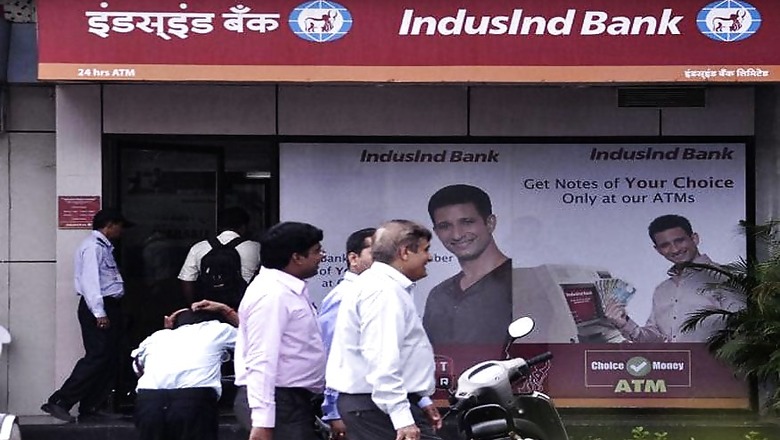
views
Mumbai: Midsize private sector lender Indusind Bank today posted a 27 per cent surge in March quarter net at Rs 953.09 crore despite a surge in bad loans as the bank disclosed a Rs 1,350-crore divergence in its bad loans reporting for the just-concluded financial year.
For the full fiscal 2017-18, the Hinduja Group-run bank reported a 27 per cent growth in its bottomline at Rs 3,605.99 crore. Indusind, known for its healthy asset quality despite its overdependence on vehicle financing which constitutes close to a third of its loan book, is the latest to join the list of NPA underreporting large private sector lenders after ICICI Bank, Axis Bank, and Yes Bank.
The maiden under-reporting of bad loans, as found by a Reserve Bank audit, had the bank counter slipping 0.6 per cent at Rs 1,834.10 after rallying over 3 percent in anticipation of the earnings announcement. Against this, the Sensex rose 0.3 per cent.
This had the bank's gross bad loans rising to 1.17 per cent of its loan book at Rs 1700 crore, and net NPAs jumping to Rs 750 crore or 0.51 per cent. This lead to a 42 per cent spike in provisions Q-o-Q at Rs 335 crore, or a 0.93 per cent rise annually from 0.73 per cent.
The core net interest income grew 20 per cent during the reporting quarter to Rs 2,007.59 crore, while a 56 per cent dip in trading income resulted in non-interest income staying flat at Rs 1,208.51 crore.
Managing director and chief executive Romesh Sobti said it did not make any mark-to-market losses on its investments, therefore there was nothing to be ammortised but there was a dip in trading income due to a massive spike in bond yields during the quarter.
The city-based bank disclosed a Rs 1,350-crore 'divergence' or under-reporting of non-performing assets found by the RBI in case of a cement account which had witnessed a merger and acquisition activity, but added that it had already provided for it in the reporting quarter.
Sobti said its impact on the gross non-performing assets stood at Rs 186 crore, while the additional provisioning had a 0.02 per cent impact on the credit cost for the entire fiscal, which ended at 0.62 per cent. The bank is aspirational to get the credit cost in the "mid-50s" basis points, Sobti said. The GNPA ratio came in almost flat at 1.17 per cent, while the overall provisions rose 42 per cent over the preceding quarter to Rs 335.55 crore.
The bank also disclosed its SMA2 assets, which are not NPAs but have not seen payment for over two months, for the first time, stating that it stands at 0.13 per cent of the overall Rs 1.44 trillion book. Analysts at HDFC Securities said the bank saw fresh slippages doubling to Rs 860 crore or 2.52 per cent from 1.3 per cent from the corporate segment.
The report also said this is the second time in a row that the bank has reported divergence in the NPAs. As per the RBI assessment, it said FY17 GNPAs are higher by Rs 1,350 crore or 1.19 per cent of the loan book and net NPAs rose by Rs 1000 crore or 0.88 per cent of the loan book, taking its exposure to NCLT accounts rose to Rs 385 crore, HDFC Securities said.
"Though asset quality deterioration and divergence will weigh on the stock in the near-term," they warned. Sobti said the bank has a "double-digit" crore exposure to one of the two companies mired in the PNB scam, but not disclose the name of Gitanjali Gems, and said it has already classified the account as a "fraud" account and made provisions accordingly.
A senior bank official said it has re-shuffled its exposure to the gems & jewellery companies, despite the sector having a good showing in FY18 on good demand globally. Net interest margin slipped marginally to 3.97 per cent and Sobti said it is targeting to maintain it at 4 per cent, even though the lesser yielding loans to vehicle purchases are growing at a faster clip.
Credit growth rose 28 per cent, led by an impressive showing by the vehicle finance book (47 per cent growth), non-vehicle finance retail book (30 per cent) and 30 per cent growth in corporate loan book driven by working capital loans.
When asked if it is going too fast in the corporate side in the wake of the difficulties faced by the state-run lenders, Sobti said the bank is not targeting to gain market share and has set a growth trajectory where it wants to expand at 25-30 per cent.
Share of the low-cost current and saving deposits grew to 44.01 per cent during the fiscal from the 36.85 per cent in the year-ago period. The bank did experience some difficulties on ATM replenishments in the poll-bound Karnataka and had to send cash from other locations quickly to meet demand, a senior official said, commenting on the cash crunch.

















Comments
0 comment